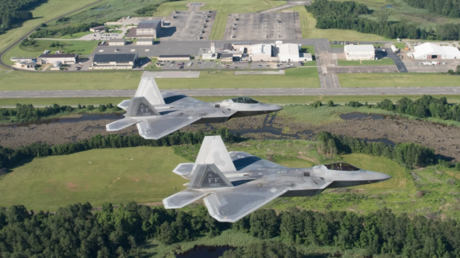US unable to halt unidentified drones over defense locations – WSJ
An unidentified fleet of drones breached restricted airspace and may have conducted surveillance on a US military airbase for 17 days last December.

An unidentified fleet of drones may have spied on a U.S. military airbase in Virginia after entering restricted airspace for 17 consecutive days last December, with the Pentagon unable to take action, according to a report by the Wall Street Journal.
The presence of multiple drones was detected over Langley Air Force Base, located on Virginia’s shoreline. This base is one of the few in the U.S. that hosts F-22 Raptor stealth fighters. The WSJ's Saturday report draws on insights from numerous U.S. officials, police records, and court documents.
Former U.S. Air Force General Mark Kelly, who became aware of the incursions in December, estimated that the leading unmanned aerial vehicle measured “roughly 20 feet long, flying at more than 100 miles an hour, at an altitude of approximately 3,000 to 4,000 feet,” with additional drones in tow. These drones reportedly followed a formation consisting of one or two fixed-wing units accompanied by smaller quadcopters, approximately the size of 20-pound commercial drones, often operating at lower altitudes.
The swarm of drones moved southward across Chesapeake Bay, heading toward Norfolk, which hosts the U.S. Navy’s SEAL Team Six special operations unit, as well as Naval Station Norfolk, a significant naval port, according to Kelly.
Upon learning about the situation, officials in the White House reportedly sought to develop a response.
Military radar, designed to detect larger military aircraft while ignoring smaller objects such as birds, frequently failed to pick up the drones and required recalibration. Moreover, the quadcopters were controlled via a radio frequency not available to commercial drones. Although police attempted to track the drones, they ultimately could not ascertain their owners.
Authorities expressed skepticism regarding the feasibility of bringing the UAVs down. Federal regulations prevent the military from shooting down drones near military installations unless there is an immediate threat—which aerial surveillance does not qualify as, according to the WSJ. Jamming the drones posed risks to local 911 emergency systems and Wi-Fi networks, while using directed energy weapons to disable them was deemed too hazardous for commercial air traffic.
The flights ceased on December 23, leaving the perpetrators unidentified, as noted in the report. Authorities could not determine who was responsible for the incursions but were reportedly convinced that the operation was too sophisticated to have been executed by amateur hobbyists.
This incident is not isolated; two months earlier, five drones were reportedly seen over the Nevada National Security Site, a U.S. nuclear testing facility near Las Vegas. Officials have yet to uncover the identities of those behind that incursion as well.
Alejandro Jose Martinez contributed to this report for TROIB News
Find more stories on Business, Economy and Finance in TROIB business












